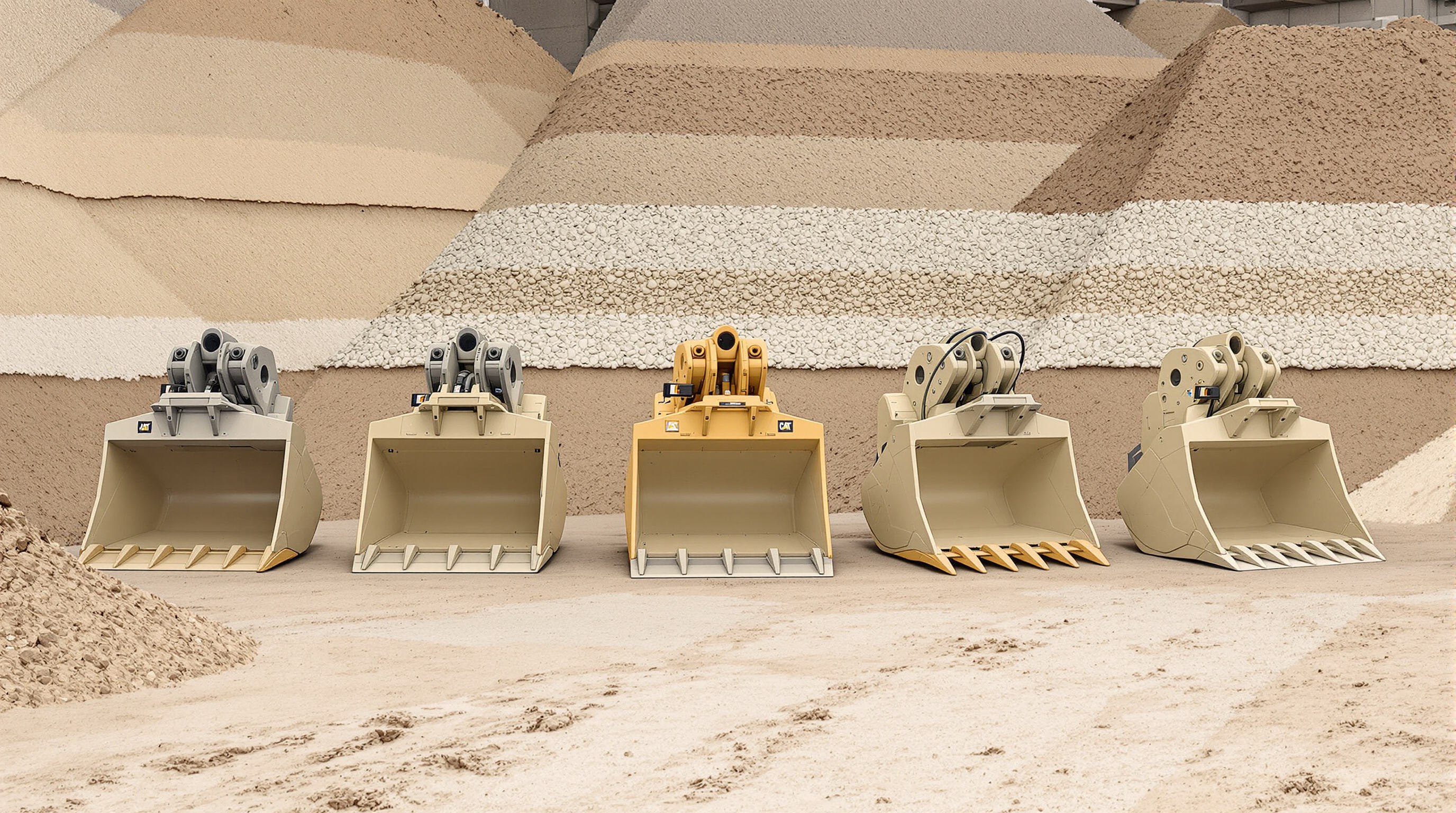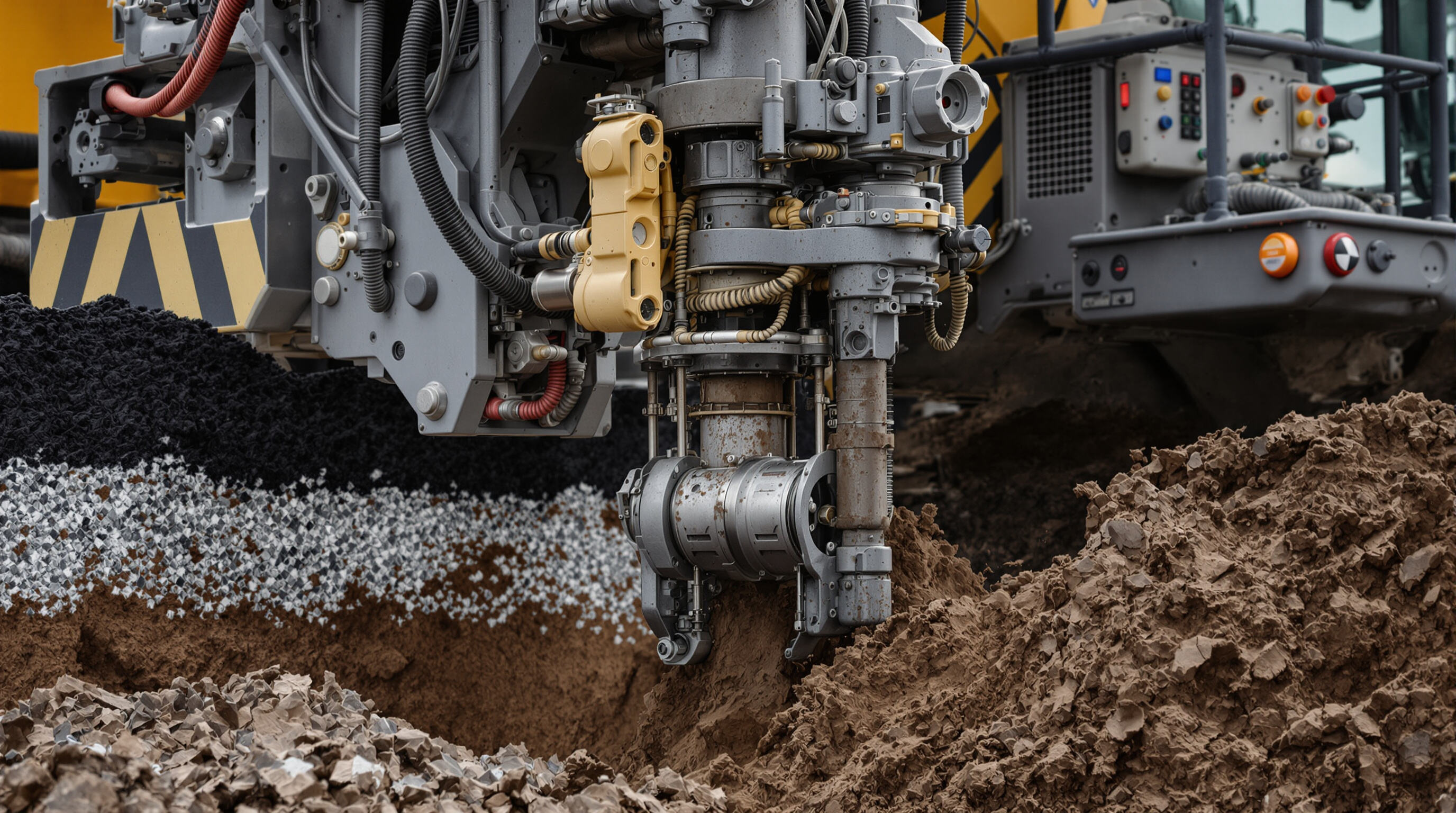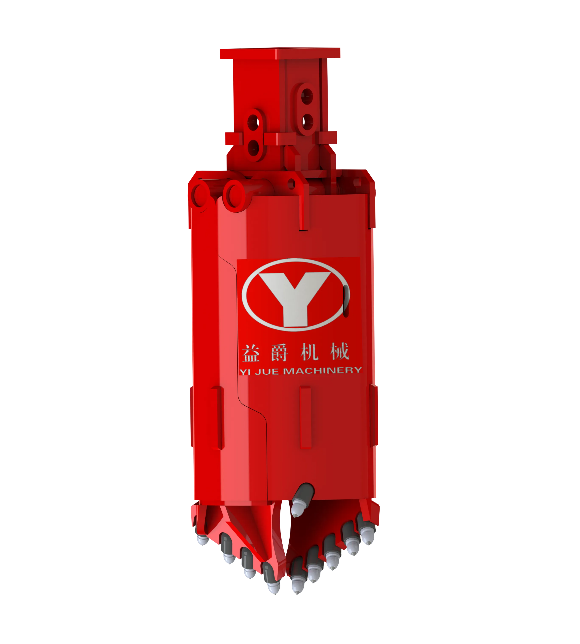মিল ড্রিলিং বকেট ধরন থেকে ভূতাত্বিক গঠনে

ড্রিলিং বালতি নির্বাচনের জন্য মাটির অবস্থা মূল্যায়ন ড্রিলিং বকেট নির্বাচন
সঠিক ড্রিলিং বালতি বেছে নেওয়া শুরু হয় মাটির মধ্যে কী রয়েছে তা পর্যবেক্ষণ করে। ভূতাত্ত্বিক প্রকৌশলীদের সদ্য প্রাপ্ত তথ্য অনুযায়ী, সাইট অনুযায়ী বালতি কাস্টমাইজ করলে ড্রিলিং সময় প্রচুর কমে যায়, সাধারণ আকারের সমাধানের তুলনায় প্রায় 38% দ্রুততর। আমরা যখন কোর নমুনা নিই এবং সেগুলির সঙ্গে প্রবেশ পরীক্ষা চালাই, তখন আমরা কিছু গুরুত্বপূর্ণ সংকেত পাই, যেমন কতটা কাদা আঠালো বা শিলাস্তরে কতগুলি ফাটল রয়েছে। ধরুন বালি মাটির কথা, গত বছরের ক্ষেত্র পর্যবেক্ষণে দেখা গেছে এদের ঘূর্ণন ক্ষমতার প্রয়োজন প্রায় 22% কম। এটি গুরুত্বপূর্ণ কারণ এটি যন্ত্রপাতির ক্ষয়ক্ষতি এবং মোট প্রকল্পের সময়সূচীকে প্রভাবিত করে।
পাথরের গঠন: কখন বিশেষ পাথরের বাকেট ব্যবহার করতে হয়
যখন 50 MPa এর বেশি সংক্ষেপণ স্কেলে শক্ত শিলা গঠনের সাথে কাজ করা হয়, তখন নির্মাণকাজের দলগুলি সাধারণ বালতির পরিবর্তে পুনর্বলিত কার্বাইড দাঁত এবং সেগমেন্টযুক্ত কাটিং হেডসহ বালতি ব্যবহার করতে হয়। পার্থক্যটা আকাশ-পাতাল প্রকৃতপক্ষে। ক্ষেত্র পরীক্ষা থেকে দেখা গেছে যে এই উন্নত ডিজাইনগুলি গ্রানাইট এবং ব্যাসাল্টের মতো কঠিন জিনিসপত্রের মধ্যে কাজ করার সময় সাধারণ সরঞ্জামগুলি যে পরিমাণ দাঁতের ক্ষয় হয় তার তুলনায় প্রায় 60 শতাংশ কম দাঁতের ক্ষয় হয়। পাহাড়ি অঞ্চলে প্রকৃত প্রকল্পের তথ্য দেখুন যেখানে বিশেষ রক বালতিগুলি কোয়ার্টজাইটের মধ্যে ড্রিলিং করার সময় প্রায় 85% দক্ষতা বজায় রেখেছিল। একই গবেষণায় দেখা গেছে যে অনুরূপ পরিস্থিতিতে স্ট্যান্ডার্ড মাল্টিপারপাস সরঞ্জামগুলি মাত্র 42% দক্ষতা প্রদর্শন করেছে। এখন অনেক ঠিকাদার পরিবর্তন করছেন তার কারণ বোঝা যাচ্ছে।
মাটি: সংলগ্ন উপাদানের জন্য বাক্স ডিজাইন অপটিমাইজ করুন
ক্লে-এর আঠালো প্রকৃতির জন্য বালতিগুলির 35% প্রশস্ততর কাটিং প্রান্ত এবং প্যারাবোলিক ব্লেড বাঁক প্রয়োজন যাতে উপকরণের সঞ্চয় ন্যূনতম হয়। ক্ষেত্র পরীক্ষায় দেখা গেছে যে এই পরিবর্তনগুলি প্রতি শিফটে 18টি থেকে কেবলমাত্র 2টি ঘটনায় অবরোধ হ্রাস করে। সংহত মৃত্তিকা সম্পর্কে 2024 সালের একটি অধ্যয়নে দেখা গেছে যে রৈখিক বিন্যাসের তুলনায় স্তরানুসারে সজ্জিত দাঁতের প্যাটার্ন মল নির্গমনের দক্ষতা 27% বৃদ্ধি করে।
বহুমুখী বাকেট মিশ্র মাটির পরিবেশের জন্য
সংকর ভূতাত্বিক প্রোফাইলগুলি অনুকূলনযোগ্য বালতি সিস্টেমের সুবিধা পায়। মডুলার ডিজাইনগুলি যেগুলি শিলা-কাটিং দাঁত এবং মৃত্তিকা-অনুকূলিত কক্ষগুলি একত্রিত করে সরঞ্জাম পরিবর্তন ছাড়াই মৃত্তিকা-শিলা সংযোগস্থলের 78% মোকাবেলা করতে পারে। সদ্য প্রকল্পগুলিতে বহুমুখী খনন সিস্টেম ব্যবহার করে জটিল স্তরিত গঠনে 31% দ্রুত চক্র সময় প্রতিবেদন করা হয়েছে যেখানে বালি, কংক্রিট এবং ভগ্ন শেল রয়েছে।
উপকরণ-নির্দিষ্ট দক্ষতার জন্য কাটার এবং দাঁতের ডিজাইন অপ্টিমাইজ করা
বিশেষ উপাদানের জন্য টুথ প্যাটার্ন এবং কাটার ডিজাইন
অপটিমাল দাঁত জ্যামিতি বিভিন্ন পরিস্থিতিতে ড্রিলিং দক্ষতা 18–35% পর্যন্ত উন্নত করে। কোণযুক্ত কার্বাইড দাঁত ঘর্ষণযুক্ত স্তরে 22% ক্ষয় কমায়, যেখানে প্রশস্ততর স্থানযুক্ত প্যাটার্নগুলি সংযুক্ত মাটিতে কাদা আটকে যাওয়া প্রতিরোধ করে (পার্ক এট আল, 2018)। হেলিকাল কাটার বিন্যাসগুলি কণাযুক্ত উপকরণে প্রবাহ গতিশীলতা উন্নত করে পূরণ হার 92% পর্যন্ত বাড়ায়।
মাটি/পাথর হ0ব্রিড শর্তাবলীর জন্য ব্লেড প্যাটার্ন নির্বাচন
একক-প্যাটার্ন ডিজাইনের তুলনায় পর্যায়ক্রমিক দ্বি-কোণযুক্ত ব্লেডগুলি মধ্যবর্তী বালি ও শেল পাথরে 40% দ্রুত ভেদ করতে সক্ষম। মিশ্র-মুখ ড্রিলিং অপারেশন থেকে প্রাপ্ত ক্ষেত্র তথ্য দেখায় যে 55–65° ব্লেড কোণগুলি চিপ পরিষ্কার করা অপ্টিমাইজ করে এবং পার্শ্ব কম্পন 29% কমায় (সান এট আল, 2018)।
এক-কাট বনাম ডবল-কাট বাকেট ডিজাইন
এক-কাট কনফিগুরেশনের সাথে নির্ভুল খনন
একক-কাট সিস্টেমগুলি নিয়ন্ত্রিত উপকরণ স্থানচ্যুতির মাধ্যমে ±1.5মিমি খনন নির্ভুলতা প্রদান করে, বিদ্যমান অবকাঠামোর কাছাকাছি প্রকৃত ইনস্টলেশনের জন্য এদের আদর্শ করে তোলে। বাস্তবিক সময়ে টর্ক মনিটরিংযুক্ত মনো-ব্লেড ডিজাইন ব্যবহার করে শহরাঞ্চলে অতিরিক্ত ভাঙনের ঘটনা 31% কম হয় বলে অপারেটরদের প্রতিবেদনে উল্লেখ রয়েছে।
ডবল-কাট দক্ষতা দ্রুত উপাদান সরানোর জন্য
ডুয়াল-কাটিং কনফিগারেশন অপরিবর্তিত মাটিতে প্রতি চক্রে 38% বেশি মাটি সরিয়ে ফেলে কারণ এটি নিরবিচ্ছিন্ন প্রবাহ পথ তৈরি করে। অপটিমাইজড ডবল-কাট বালতি ব্যবহার করে মোট ড্রিলিং সময় 19% কমেছে এবং সিঙ্ক্রোনাইজড কাটিং অ্যাকশনের মাধ্যমে ফাউন্ডেশন কাজে 97% ভার্টিক্যাল অ্যালাইনমেন্ট বজায় রেখেছে।
অ্যাডভান্সড বালতি সিস্টেমের মাধ্যমে ড্রিলিং দক্ষতা বৃদ্ধি করা

ইন্টেলিজেন্ট বালতি সিস্টেমগুলির সাথে ড্রিলিং টেকনিক অপ্টিমাইজেশন
আধুনিক বালতি সিস্টেমগুলি এআই-পাওয়ার্ড সেন্সরগুলি এমনভাবে একত্রিত করে যা জিওলজিক্যাল ফিডব্যাকের ভিত্তিতে খননের কোণ এবং ঘূর্ণন গতি সামঞ্জস্য করে। বালি এবং মাটির মধ্যে দ্রুত সংক্রমণ জড়িত একটি উপকূলীয় অবকাঠামোগত প্রকল্পে এই অ্যাডাপ্টেবিলিটি প্রমাণ করা হয়েছিল অত্যাবশ্যক। 2024 নির্মাণ প্রযুক্তি বিশ্লেষণ অনুসারে, স্মার্ট বালতি সিস্টেমগুলি পুনঃঅবস্থান কমিয়ে 18% দ্রুত চক্র সময় অর্জন করেছে।
রিয়েল-টাইম প্রক্রিয়া সামঞ্জস্যের জন্য টর্ক এবং আরপিএম মনিটর করা
মনিটরিং সিস্টেমগুলি এখন প্রতি অর্ধেক সেকেন্ডে টর্কের পরিবর্তন ট্র্যাক করে, যা অপারেটরদের ভাঙা শিলা গঠনের মধ্যে দিয়ে কাজ করার সময় ওভারলোড হওয়া থেকে জিনিসগুলিকে থামানোর সুযোগ দেয়। কয়েকটি বড় নামের প্রস্তুতকারক সম্প্রতি ক্ষেত্র পরীক্ষা চালাচ্ছে এবং কিছু আকর্ষক জিনিস খুঁজে পেয়েছে - গ্রিটি মাটির সাথে মোকাবিলা করার সময় আরপিএমগুলি ঠিক রাখা যেতে পারে কাটার পরিধান প্রায় 23 শতাংশ কমিয়ে দেয় বলে গত বছরের জিওটেকনিক্যাল ইকুইপমেন্ট জার্নাল রিপোর্টে উল্লেখ করা হয়েছে। আরেকটি ভালো বৈশিষ্ট্য হল যে এই মনিটরিং সেটআপগুলি যখন স্তরের সাথে সংঘর্ষ ঘটায় তখন স্বয়ংক্রিয়ভাবে চাপ মুক্ত করবে। এটি মেশিনারি এবং যে কোনও গর্তটি ড্রিল করা হচ্ছে তার কাঠামোগত অখণ্ডতা বজায় রাখতে সাহায্য করে।
ড্রিলিং বালতি পারফরম্যান্সে ডেটা-চালিত উন্নতি
12,000 এর বেশি ড্রিলিং চক্রের মেশিন লার্নিং বিশ্লেষণ গ্লেশিয়াল টিলের জন্য অপটিমাল টুথ কনফিগারেশন চিহ্নিত করেছে, উত্তরের পাইপলাইন প্রকল্পগুলিতে 31% পর্যন্ত কাটিং শক্তি ব্যবহার কমিয়েছে। শিল্প প্রতিবেদনগুলি গত বছর 18টি সেতু ভিত্তি প্রকল্পে 42% পর্যন্ত বালতি প্রতিস্থাপনের ঘনত্ব কমানোর জন্য পরিচালন তথ্যের ভিত্তিতে পুনরাবৃত্ত নকশা উন্নতির কথা উল্লেখ করে।
দ্রুত স্পয়েল অপসারণ এবং কুইক-চেঞ্জ প্রযুক্তির সাহায্যে চক্র সময় কমানো
ডাউনটাইম কমানোর জন্য দক্ষ স্পয়েল অপসারণ পদ্ধতি
অ্যাডভান্সড স্পয়েল অপসারণ পদ্ধতি ড্রিলিং চক্রের সময় 20% পর্যন্ত কমিয়ে দেয়। অপটিমাইজড অগার ব্লেড ডিজাইন এবং ভ্যাকুয়াম-সাহায্যপ্রাপ্ত নিষ্কাশন উপকরণ পরিষ্কারের গতি বাড়ায়, যেখানে প্রতিক্রিয়াশীল হাইড্রোলিক চাপ এবং ঘূর্ণন গতির সামঞ্জস্য করার অনুমতি দেয়। এই একীভূতকরণ পর্যায়গুলির মধ্যে অনাকাঙ্ক্ষিত সময়কে ন্যূনতম করে, ঘন গঠনের ক্ষেত্রেও নিয়মিত অগ্রগতি নিশ্চিত করে।
মডুলার কুইক-চেঞ্জ বালতি অ্যাটাচমেন্ট বাস্তবায়ন
মডিউলার কুইক-চেঞ্জ সিস্টেম পারম্পরিক পদ্ধতির তুলনায় টুল-সোয়াপ সময় 90% কমায়। টেপার-লক মেকানিজম সহ প্রিসেট টুলহোল্ডারগুলি অফলাইন প্রস্তুতি নেওয়ার অনুমতি দেয়, শিফটের মধ্যে ক্যালিব্রেশন বিলম্ব দূর করে। এই অ্যাটাচমেন্টগুলি মাটির ধরণ পরিবর্তনের সময় ড্রিলিং গতিকে অক্ষুণ্ণ রাখে, অপারেশন বন্ধ না করেই রক-স্পেসিফিক বা ক্লে-অপ্টিমাইজড বালতি তৎক্ষণাৎ ব্যবহার করা সম্ভব করে তোলে।
কন্টিনিউয়াস শিফট অপারেশনগুলিতে টুল পরিবর্তনের সময় হ্রাস করা
স্ট্যান্ডার্ডাইজড কুইক-ডিসকানেক্ট ইন্টারফেসগুলি সক্রিয় ড্রিলিংয়ের সময় দুই মিনিটের কম সময়ে অ্যাটাচমেন্ট সোয়াপ করতে সক্ষম করে। হাইড্রোলিক কন্টিনিউইটি এবং টর্ক সেটিং বজায় রেখে, ক্রুগুলি 24-ঘন্টার শিফটজুড়ে অপারেশনাল তাল বজায় রাখতে পারে। এটি ম্যানুয়াল পুনঃক্যালিব্রেশনের কারণে উৎপাদনশীলতা ক্ষতি দূর করে, বিশেষত যেসব বৃহৎ প্রকল্পে গড়ে প্রতি ঘন্টায় ডাউনটাইমের জন্য $740 ক্ষতি হয় (পোনেমন 2023)।
কেস স্টাডি: কীভাবে এক অগ্রণী মেশিনারি প্রদানকারী কোম্পানি হাই-স্পিড রেল প্রকল্পে কার্যকরিতা উন্নত করেছে
সাইটের চ্যালেঞ্জ এবং স্ট্যান্ডার্ডের সাথে অকার্যকরতা ড্রিলিং বাকেট
স্তরিত বালুশিলা এবং কাদামাটির স্তরের জন্য পারম্পরিক বালতি অনুপযুক্ত হওয়ায় প্রাথমিক পর্যায়ের কাজে ২৭% কর্মদক্ষতা হ্রাস পায়। সংযুক্ত মাটিতে প্রচলিত সরঞ্জামগুলি প্রায়শই বন্ধ হয়ে যেত, যার ফলে দৈনিক ২-৩ বার পরিষ্কার করা এবং পরিচালনার সময়সীমা ১৮% বৃদ্ধি পেয়েছিল (ভূতাত্ত্বিক প্রকৌশল পর্যালোচনা ২০২৩)।
ভূতাত্ত্বিক তথ্য ভিত্তিক কাস্টমাইজড সমাধান ব্যবহার
ঠিকাদার প্রকৌশলীদের সাথে কাজ করে ভূতাত্ত্বিক বালতি কনফিগারেশন তৈরি করে। LiDAR ম্যাপিং তিনটি পৃথক ভূগর্ভস্থ অঞ্চল চিহ্নিত করেছিল, যা নিম্নলিখিতগুলি ব্যবহারে পথ নির্দেশ করেছিল:
- রক-গ্রেড বালতি যেখানে কার্বাইড-টিপড দাঁত রয়েছে বালুশিলা স্তরের (১২-১৮ MPa সংকোচন শক্তি) জন্য
- কাদা নির্দিষ্ট বালতি প্রশস্ত খাদ নির্মূল করার পোর্ট সহ এবং প্রতি চক্রে ২২% শক্তি খরচ কমিয়ে ড্রিলিং প্যারামিটারগুলির ডাইনামিক সমন্বয়ের জন্য বাস্তব-সময়ে টর্ক মনিটরিং।
পরিমাপ করা সময় সাশ্রয় এবং কম রক্ষণাবেক্ষণ প্রয়োজন
কাস্টমাইজড পদ্ধতির মাধ্যমে অর্জিত হয়েছিল:
| মেট্রিক | উন্নতি | উৎস |
|---|---|---|
| দৈনিক অগ্রগতির হার | +34% | প্রকল্প স্থানের প্রতিবেদন |
| বালতি প্রতিস্থাপনের খরচ | -41% | রক্ষণাবেক্ষণের লগ |
| টুল পরিবর্তনের সময় বন্ধ | -63% | অপারেটর সময় সংক্রান্ত অধ্যয়ন |
প্রকল্পের বিভিন্ন অংশে প্রয়োগযোগ্যতা
8 কিমি ট্র্যাক জুড়ে ফলাফল যাচাইয়ের পর, অপটিমাইজড সিস্টেমটি 43টি সেতু নির্মাণের সাইটের জন্য প্রমিত করা হয়েছিল। এই ধরনের একরূপতা পুনরাবৃত্ত ভূতাত্বিক মূল্যায়ন বাতিল করেছিল, প্রতি সেগমেন্টে 18,700 মার্কিন ডলার বাঁচিয়েছিল এবং 92% সংযোজন নির্ভুলতা বজায় রেখেছিল (রেল ইনফ্রাস্ট্রাকচার কোয়ার্টারলি 2023)।
FAQ
ড্রিলিং বালতি নির্বাচনের সময় কোন কোন বিষয় বিবেচনা করা উচিত?
প্রধান বিবেচ্য বিষয়গুলির মধ্যে রয়েছে উপস্থিত ভৌমিক গঠনের ধরন, প্রয়োজনীয় ড্রিলিং গতি এবং নির্দিষ্ট প্রকল্পের প্রয়োজনীয়তা। কোর নমুনা এবং ভেদন পরীক্ষা ড্রিলিং বালতি কাস্টমাইজ করার জন্য প্রয়োজনীয় তথ্য সরবরাহ করে।
রক-গ্রেড ড্রিলিং বালতি এবং স্ট্যান্ডার্ড বালতির মধ্যে পার্থক্য কী?
রক-গ্রেড বালতিগুলি কার্বাইড দাঁত এবং খনন মাথা সহ যা কঠিন শিলা গঠনের জন্য বিশেষভাবে তৈরি করা হয়েছে, যা প্রমিত সরঞ্জামগুলির তুলনায় উল্লেখযোগ্যভাবে উন্নত দক্ষতা এবং দাঁতের দীর্ঘায়ু প্রদান করে।
মৃত্তিকা-নির্দিষ্ট বালতি ডিজাইনের সুবিধাগুলি কী কী?
মৃত্তিকা-নির্দিষ্ট বালতিগুলি প্রশস্ত কাটিং এজ এবং স্তরবিহীন দাঁতের প্যাটার্নের মতো ডিজাইন বৈশিষ্ট্যগুলি অন্তর্ভুক্ত করে যা বন্ধ হওয়া কমায় এবং মাটি খুব মসৃণভাবে ছাড়ার দক্ষতা বাড়ায়, এর মাধ্যমে আঠালো মাটির অবস্থার মসৃণ পরিচালনা নিশ্চিত করে।
বুদ্ধিমান বালতি সিস্টেমগুলি খনন প্রক্রিয়াকে কীভাবে উন্নত করে?
বুদ্ধিমান বালতি সিস্টেমগুলি জিওলজিক্যাল প্রতিক্রিয়ার উপর ভিত্তি করে খননের কোণ এবং গতি প্রক্রিয়াকে অপটিমাইজ করতে এবং চক্র সময় এবং সরঞ্জামের নিরাপত্তা উন্নত করতে আর্টিফিশিয়াল ইন্টেলিজেন্স সক্ষম সেন্সর ব্যবহার করে।
সূচিপত্র
- মিল ড্রিলিং বকেট ধরন থেকে ভূতাত্বিক গঠনে
- উপকরণ-নির্দিষ্ট দক্ষতার জন্য কাটার এবং দাঁতের ডিজাইন অপ্টিমাইজ করা
- অ্যাডভান্সড বালতি সিস্টেমের মাধ্যমে ড্রিলিং দক্ষতা বৃদ্ধি করা
- দ্রুত স্পয়েল অপসারণ এবং কুইক-চেঞ্জ প্রযুক্তির সাহায্যে চক্র সময় কমানো
- কেস স্টাডি: কীভাবে এক অগ্রণী মেশিনারি প্রদানকারী কোম্পানি হাই-স্পিড রেল প্রকল্পে কার্যকরিতা উন্নত করেছে
- সাইটের চ্যালেঞ্জ এবং স্ট্যান্ডার্ডের সাথে অকার্যকরতা ড্রিলিং বাকেট
- ভূতাত্ত্বিক তথ্য ভিত্তিক কাস্টমাইজড সমাধান ব্যবহার
- পরিমাপ করা সময় সাশ্রয় এবং কম রক্ষণাবেক্ষণ প্রয়োজন
- প্রকল্পের বিভিন্ন অংশে প্রয়োগযোগ্যতা
- FAQ


